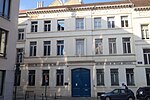Halle Gate

The Halle Gate (French: Porte de Hal, Dutch: Hallepoort) is a former medieval city gate and the last vestige of the second walls of Brussels, Belgium. Built between 1381 and 1383, it was heavily restored in the 19th century in its current neo-Gothic style by the architect Henri Beyaert. It is now a museum dedicated to the medieval City of Brussels, part of the Royal Museums of Art and History (RMAH).The Halle Gate is located on Boulevard du Midi/Zuidlaan between the City of Brussels and Saint-Gilles municipalities. This site is served by Brussels-South railway station, as well as by the metro and premetro (underground tram) station Porte de Hal/Hallepoort on lines 2, 3, 4 and 6.
Excerpt from the Wikipedia article Halle Gate (License: CC BY-SA 3.0, Authors, Images).Halle Gate
Boulevard du Midi - Zuidlaan, City of Brussels
Geographical coordinates (GPS) Address Nearby Places Show on map
Geographical coordinates (GPS)
| Latitude | Longitude |
|---|---|
| N 50.833055555556 ° | E 4.3447222222222 ° |
Address
Porte de Hal - Hallepoort
Boulevard du Midi - Zuidlaan 150
1000 City of Brussels (Brussels)
Belgium
Open on Google Maps








